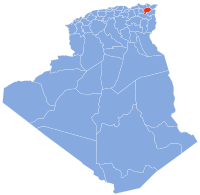Hammam Maskhoutine: Difference between revisions
No edit summary |
→Gallery: first of all there's no such thing |
||
| Line 86: | Line 86: | ||
File:Hammam Debagh حمام دباغ 03.jpg|Another view of the springs |
File:Hammam Debagh حمام دباغ 03.jpg|Another view of the springs |
||
File:Source et chute d'eau du Hammam Meskhoutine.JPG|Source and flowing channels of the hot spring |
File:Source et chute d'eau du Hammam Meskhoutine.JPG|Source and flowing channels of the hot spring |
||
File:Des touriste locale du Hammam Meskhoutine.JPG| |
File:Des touriste locale du Hammam Meskhoutine.JPG|People beneath the cascade |
||
File:Hammam Debagh حمام دباغ 08.jpg|Hot spring channels with some view of the town |
File:Hammam Debagh حمام دباغ 08.jpg|Hot spring channels with some view of the town |
||
File:Hammam Meskhoutine vu d'en bas.JPG|Closer view of the flowing [[travertine]] formations |
File:Hammam Meskhoutine vu d'en bas.JPG|Closer view of the flowing [[travertine]] formations |
||
Revision as of 01:21, 12 October 2018
Hammam Maskhoutine
حمام المسخوطين | |
|---|---|
Commune and town | |
 | |
| Country | |
| Province | Guelma Province |
| Time zone | UTC+1 (CET) |
Hammam Maskhoutine (Arabic: حمام المسطوطين, English: "bath of the damned")[1] is a thermal complex and commune located in Hammam Debagh, of Guelma Province, Algeria.[2] The dramatic, multicolored travertine walls of the spring have attracted attention from locals and tourists alike since the era of the Roman Empire.[1]
Hammam Maskhoutine is the historical name for this general area, also used to refer to the hot springs and the legend that named the town.[2] Hammam Dbegh is the official name of the town itself, and Hammam Chellala is the name of the thermal complex and cascade.[2]
History
During the Roman occupation, the town was called Aquae Thiblitanae, due to its proximity to Thibilis.[1][3] The bath facilities installed by the Romans at the spring can still be used today.[1]
The Arabic name of the town comes from a local legend in which a man married his sister. As the wedding procession, including the incestuous couple, moved up the valley, a curse caused the skies to darken, and the entire wedding party was struck with lightning and turned to stone. The billowing shapes of the Hammam Maskhoutine spring are said to come from the still-frozen wedding party and their celebratory robes.[1]
Hot springs
Hammam Maskhoutine is actually a group of 10 different hot springs in a single valley. The temperature of the water in the springs can be as hot as 98 °C (208 °F); it is possible to boil eggs in the outflow channels.[1] The overall flow rate of the thermal complex is 1,650 liters per second: nearly 100,000 liters per minute.[citation needed]
The water is saturated with minerals such as iron and calcium carbonate. These minerals, as well as the heat, have been regarded as therapeutic for sufferers of ailments such as rheumatism and arthritis.[1]
On the site there are also numerous formations of conoid shapes.
Gallery
-
Side view of the hot springs
-
Another view of the springs
-
Source and flowing channels of the hot spring
-
People beneath the cascade
-
Hot spring channels with some view of the town
-
Closer view of the flowing travertine formations
References
- ^ a b c d e f g Scheffel, Richard L.; Wernet, Susan J., eds. (1980). Natural Wonders of the World. United States of America: Reader's Digest Association, Inc. pp. 174–175. ISBN 0-89577-087-3.
- ^ a b c "Hammam Meskhoutine - Guelma". www.guelma.org. Retrieved 2017-03-15.
- ^ "HAMMAM MESKHOUTINE". www.piedsnoirs-aujourdhui.com. Retrieved 2017-03-15.








